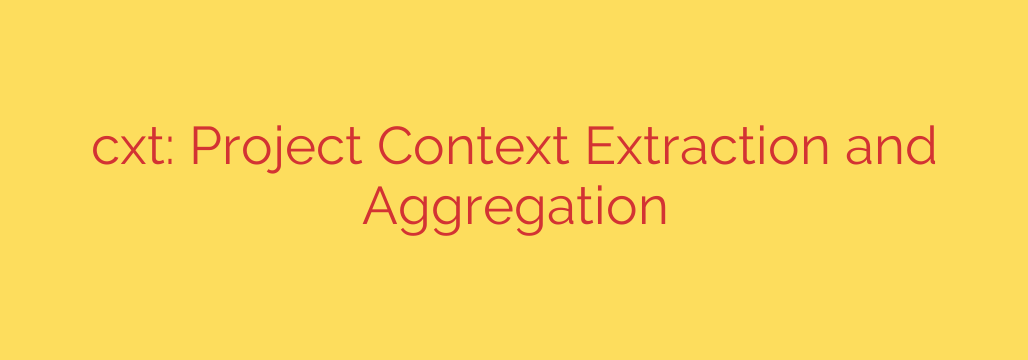
Supercharge Your AI Coding Assistant: A Better Way to Provide Project Context
In modern software development, Large Language Models (LLMs) like GPT-4 and Claude have become indispensable coding partners. They can debug complex issues, refactor code, and even generate entire features. However, their effectiveness hinges on one critical factor: the quality and completeness of the context you provide.
Developers often find themselves in a tedious loop: manually finding, opening, and copy-pasting multiple files into a prompt. This process is not only time-consuming but also prone to errors. You might forget a crucial file, miss a configuration setting, or create a confusing, poorly formatted wall of text that the AI struggles to parse.
Fortunately, there’s a more intelligent and efficient way to manage this. By using a simple command-line utility designed for context extraction, you can automate this entire process, ensuring your AI assistant gets exactly what it needs to perform at its best.
The Problem with Manual Context Gathering
Before diving into the solution, let’s break down the challenges of feeding context to an LLM by hand:
- Inefficiency: Searching for, opening, and copying content from numerous files across a project directory wastes valuable development time.
- Incomplete Information: It’s easy to forget a critical dependency, an environment variable, or a CSS file that styles a component, leading to inaccurate or incomplete suggestions from the AI.
- Formatting Chaos: Pasting code from multiple sources without clear delimiters makes it difficult for the AI to distinguish between different files, leading to confusion and subpar results.
- Context Window Limits: While context windows are growing, large projects can easily exceed them, forcing you to strategically omit code and hope for the best.
These issues create a significant bottleneck, preventing you from fully leveraging the power of your AI tools.
A Smarter Solution: Automated Project Context Aggregation
Imagine a workflow where you can instantly gather all relevant project files, format them perfectly, and copy them to your clipboard with a single command. This is precisely what a dedicated context extraction tool offers.
These utilities work by taking a list of files and directories as input. They then read the contents of each specified file and combine them into a single, cleanly formatted text block, ready to be pasted into your AI chat interface.
The primary benefits of this approach are transformative:
- Massively Increased Productivity: What once took minutes of manual effort now takes seconds. This allows you to stay focused on the problem you’re trying to solve, not the logistics of talking to an AI.
- Flawless Context Delivery: By scripting which files to include, you ensure the AI receives a complete and accurate picture of your project’s architecture every single time.
- Clear and Structured Output: The tool automatically inserts clear headers before each file’s content (e.g.,
--- file: src/components/Button.jsx ---), making the final output easy for both you and the AI to read and understand.
Key Features of an Effective Context Tool
When looking for or building a context aggregation tool, certain features are essential for a smooth developer experience.
Seamless File Aggregation
At its core, the tool must be able to take multiple file and directory paths and concatenate their content. Advanced tools even support glob patterns (e.g., src/**/*.js), allowing you to grab all JavaScript files within a source directory instantly.
Intelligent .gitignore Integration
A truly powerful feature is the ability to automatically respect your project’s .gitignore file. This means the tool will intelligently skip node_modules, build artifacts, and other ignored files, keeping your context clean, relevant, and concise. This prevents you from accidentally polluting your prompt with thousands of lines of unnecessary code from third-party libraries.
Clipboard Automation
The most significant time-saver is automatic integration with your system’s clipboard. After processing the files, the tool should place the final formatted text directly onto your clipboard. This eliminates the final manual step, making the entire process a one-command action: run the command, switch to your browser, and paste.
A Crucial Note on Security: Protect Your Sensitive Data
While these tools enhance productivity, it’s vital to be mindful of security. The convenience of aggregating project data can become a risk if not handled carefully.
Never paste sensitive information into a public AI model. This includes:
- API keys and authentication tokens
- Database credentials and passwords
- Personal user data
- Proprietary algorithms or business-critical source code
Publicly hosted LLMs may use your prompts for future training, and there is always a risk of data exposure. Before running a context tool, always review the files you are including. Sanitize your code by removing any confidential data or use enterprise-grade AI solutions that offer private, secure environments for sensitive work.
Final Thoughts
Integrating an automated context extraction tool into your development workflow is a simple yet powerful step toward maximizing your efficiency with AI. By eliminating tedious manual work and ensuring your AI assistant receives clean, complete, and well-structured information, you can get better answers faster.
Stop wasting time with copy-pasting and start having more productive, context-aware conversations with your AI coding partner.
Source: https://www.linuxlinks.com/cxt-extract-aggregate-project-context/








